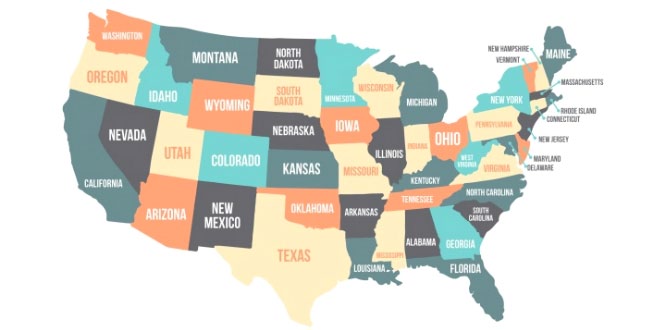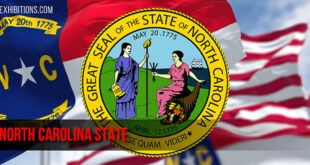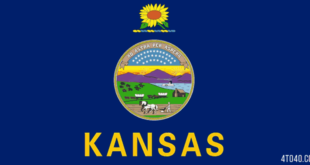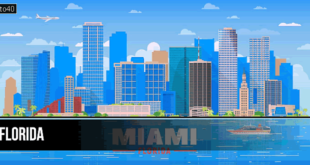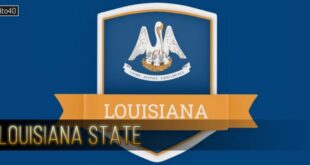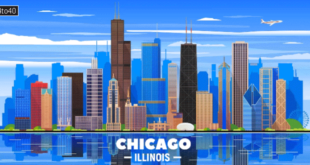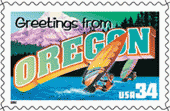 The capital is Salem. The origin of the name Oregon is uncertain, but one account traces the name to a corruption of the French word for Wisconsin (Ouisconsin). The name Oregon was first applied to a fictitious river, believed to rise in the upper Midwest and to flow westward to the Pacific Ocean. For many years the region was known as the “American West”. During the 1840s it was defined as Oregon Territory, extending from the Rocky Mountain continental divide to the Pacific Ocean and from California to Alaska. Oregon, the Beaver State, was admitted to the Union in 1859, and the remaining part of the original territory now forms the Canadian province of British Columbia and the states of Washington and Idaho and western Montana.
The capital is Salem. The origin of the name Oregon is uncertain, but one account traces the name to a corruption of the French word for Wisconsin (Ouisconsin). The name Oregon was first applied to a fictitious river, believed to rise in the upper Midwest and to flow westward to the Pacific Ocean. For many years the region was known as the “American West”. During the 1840s it was defined as Oregon Territory, extending from the Rocky Mountain continental divide to the Pacific Ocean and from California to Alaska. Oregon, the Beaver State, was admitted to the Union in 1859, and the remaining part of the original territory now forms the Canadian province of British Columbia and the states of Washington and Idaho and western Montana.
Oregon State: Land & Resources
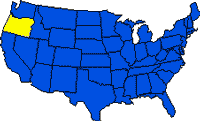 The Seven distinct physical regions are generally recognized. The COAST RANGE (highest elevation: Marys Peak, 1,249 m/4,097 ft), is 320 km (200 mi) long and from 50 to 100 km (30 to 60 mi) wide; it extends along the state’s coast in the west. Most of the surface is best described as rough, hilly land rather than as mountainous terrain, but in several places bold headlands on the coast and rugged peaks in the interior rise above the general level. The Klamath Mountains, sometimes called the Siskiyou Mountains (highest elevation: Mount Ashland, 2,296 m/7,533 ft), extend southeast from the Coast Range near the California border. They are higher, older, and more rugged than the Coast Range. Lofty ridges trend northeast-southwest, between which are several small lowlands. The best known of these lowlands is the Rogue River Valley.
The Seven distinct physical regions are generally recognized. The COAST RANGE (highest elevation: Marys Peak, 1,249 m/4,097 ft), is 320 km (200 mi) long and from 50 to 100 km (30 to 60 mi) wide; it extends along the state’s coast in the west. Most of the surface is best described as rough, hilly land rather than as mountainous terrain, but in several places bold headlands on the coast and rugged peaks in the interior rise above the general level. The Klamath Mountains, sometimes called the Siskiyou Mountains (highest elevation: Mount Ashland, 2,296 m/7,533 ft), extend southeast from the Coast Range near the California border. They are higher, older, and more rugged than the Coast Range. Lofty ridges trend northeast-southwest, between which are several small lowlands. The best known of these lowlands is the Rogue River Valley.
The Willamette River valley (elevations generally below 130 m/430 ft) is located east of the Coast Range and is up to 80 km (50 mi) wide. The generally even surface is interrupted here and there by low isolated hills. Two-thirds of Oregon’s population lives in the valley.
The CASCADE RANGE (highest elevation: Mount HOOD, 3,427 m/11,245 ft) extends for the entire length of the state east of the Willamette River valley. The range is about 80 km (50 mi) wide. No stream crosses the Cascades in Oregon, but several passes occur at about 1,500 m (5,000 ft). Most of the range is forested, and melting snow supplies the adjacent lowlands with water during the dry summer. The Deschutes-Umatilla plateau (elevations up to about 2,100 m/6,900 ft) is located east of the Cascades. The smooth upland surface is broken by several canyons, the deepest of which is that of the Deschutes River. This plateau is Oregon’s wheat belt, producing both spring and winter wheat as well as peas and livestock. Northeast of the Deschutes-Umatilla plateau is the Blue Mountain region, the most varied of Oregon’s landscapes. At one time all of the region was covered by lava flows, but erosion has exposed areas of granite and other rocks that have been further sculptured by glaciation. Several distinct mountain masses and plateaus occur: the Wallowa Mountains and the Elkhorn and Greenhorn ranges. These were glaciated, and many lakes and spectacular landscapes resulted, including the 1.6-km-deep (1-mi) Snake River canyon.
Southeastern Oregon is made up of two distinct surfaces: the high lava plains, averaging about 1,200 m (4,000 ft) in elevation with many dry lake beds and some intermittent lakes; and further south the BASIN AND RANGE PROVINCE (highest point: Steens Mountain, 3,968 m/9,670 ft), with alternating broad basins and north-south-trending wooded ranges. Southeastern Oregon is sometimes called the Oregon Desert, but most of it is semiarid; only a few small areas have a desert climate.
Climate
Rainfall and temperature are affected mainly by altitude and the distance from the ocean. At low altitudes the January temperature varies from 2 deg C to 10 deg C (35 deg F to 50 deg F); July temperatures range from 13 deg C to 24 deg C (55 deg F to 75 deg F). Precipitation ranges from less than 250 mm (10 in) in the southeast to more than 2,500 mm (100 in) on the west slopes of the Coast Range and Cascades. In the high mountains more than half of the precipitation is in the form of snow. Almost all the precipitation occurs during winter.
Tourism
Many thousands of Oregonians and visitors from other states and countries take advantage each year of the state’s fishing, hunting, camping, skiing, cycling, and hiking facilities, helping to make travel and tourism one of Oregon’s major employers. Among the state’s various recreational establishments are Oregon’s one national park–Crater Lake–as well as national monuments, national forests, state recreational areas, county parks, and forest camps.
Oregon State: History
Early History
Indians came to Oregon at least 10,000 years ago and included the BANNOCK, CHINOOK, KLAMATH, MODOC, and NEZ PERCE tribes. The Indians changed the landscape drastically in many areas, burning the forests and grasslands in order to attract game. The coast Indians had the most stable economy, depending heavily on abundant salmon, various shellfish, seals, and an occasional stranded whale. Tribes in the interior were hunters and gatherers. The first European fur traders, even before Lewis and Clark, were welcomed by the Indians for the trinkets, tools, guns, and whiskey they provided; but the Indians resented the arrival of permanent settlers, and many battles were fought before the Indians were subdued and placed on reservations.
Many ships touched the Oregon coast in the late 1700s and early 1800s, but these contacts provided little information about the interior. From 1805 to 1806, Meriwether Lewis and William Clark made the first land exploration (see LEWIS AND CLARK EXPEDITION). Although they visited only the Columbia River and a small part of the northwestern coast, they gleaned much information about the remainder of the state from friendly Indians. Their report created much excitement in the eastern United States, including the halls of Congress, and among fur traders who had previously trapped and traded in the Rocky Mountain region. Americans began to think of taking possession of this distant land, and Great Britain was also interested. In 1811, Astoria was founded as a fur-trading station by John Jacob Astor’s AMERICAN FUR COMPANY, and the HUDSON’s BAY COMPANY soon began to trap and trade in the area.
Settlement and Economic Growth
The first white settlers arrived in the 1830s, and after 1840 immigration increased. A territorial government was formed in 1843, and provision was made to establish land ownership. A system of donation land claims was set up, by which a married man was entitled to 640 acres (250 ha) of land. Most of the claims were in the Willamette Valley. A boundary dispute with Great Britain was settled in 1846, fixing the northern border of what was to become Oregon Territory as the 49th parallel (see OREGON QUESTION). Immigration increased as many people left the Mississippi River valley where malaria, tuberculosis, smallpox, and measles were prevalent, hoping to find better health as well as new opportunities in Oregon. Many died on the way, more often from disease than from Indian attacks.
With the arrival of new settlers the population increased rapidly, from 12,000 (not counting Indians) in 1850 to 318,000 in 1890. The settlers brought with them a variety of seeds and livestock, even including hives of bees, with the intention of farming. Some, however, were diverted by the gold rush to California in 1849 and others by the discovery of gold in southwestern Oregon in 1850 and in eastern Oregon in 1860. Gold mining in the southwest and east stimulated farming and ranching, and Oregon became an exporter of wheat and beef.
In 1859, Oregon became the 33rd state to be admitted to the Union. In the 1870s railroad building aided the timber and other industries and enabled Oregon fruits to be marketed fresh in the eastern markets.
The Modern Era
The coming of the automobile in the early 1900s led to an extensive road-building program, further strengthening the economy. In the 20th century the population continued to grow, especially the urban population, as people moved to the cities from rural areas. State and local planners began to regulate the use of various resources, including forests, grasslands, fisheries, and power production. Meanwhile, schools and colleges were growing, and Oregon was producing excellent literary and artistic works. The present and future pose many problems–pollution, unemployment, depletion of resources, and the need to develop new sources of energy.
Oregon State: Land
- Area: 254,819 sq km (98,386 sq mi); rank: 9th.
- Capital: Salem (1990 census, 107,786).
- Largest city: Portland (1990 census, 437,319).
- Counties: 36.
- Elevations: highest–3,426 m (11,239 ft), at Mount Hood; lowest–sea level, at Pacific coast.
Oregon State: Symbols
Flag:

Statehood:
Feb. 14, 1859; the 33rd state
Nickname:
Beaver State
Bird:
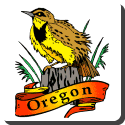
Tree:
Douglas Fir
Flower:
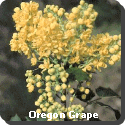
Motto:
The Union
Song:
“Oregon, My Oregon”
 Kids Portal For Parents India Kids Network
Kids Portal For Parents India Kids Network
